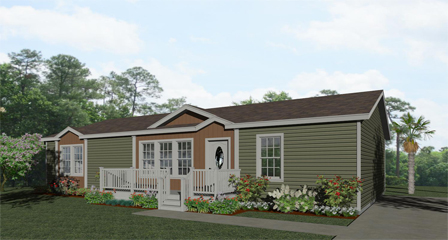House-hunting can be an exciting time, looking for the perfect fit where you can envision yourself and your family enjoying life for years to come. When you shop for a new home, however, you often hear some seemingly interchangeable terms, such as “manufactured,” “mobile,” and “modular.” In reality, these refer to different types of housing, and if you want to find the right home, it helps to speak the lingo. To that end, here’s everything you need to know about the differences between manufactured, mobile, and modular homes.
Mobile Homes: Built Before 1976
Prior to 1976, the terms mobile home and manufactured home meant essentially the same thing. In June of 1976 HUD building codes came into effect and with this came the name change from mobile homes to manufactured homes. As a result, some folks still use these terms interchangeably today, even though they have very different building standards.
The National Mobile Home Construction and Safety Act first distinguished between manufactured and mobile homes in 1974. Then, in 1976, the U.S. Department of Housing and Urban Development (HUD) instituted Manufactured Home Construction and Safety Standards. Collectively, these standards are usually called the HUD Code.
HUD Code Standards
The HUD Code formalized the definition of a manufactured home, forever setting it apart from a mobile home. This code set standards for:
- Design and construction
- Body and frame
- Thermal protection
- Plumbing and electrical
- Fire safety
- Energy efficiency
With these federal standards in place for manufactured homes, a home buyer gets certain assurances about safety and sustainability that they would’t get with a mobile home built before June of 1976.
Manufactured Homes: Built to the Federal Building Code (HUD)
Today’s manufactured home buyers can choose from a variety of floor plans and designs and customize their dwellings like never before. Manufactured home design options include luxury interior features as well as exterior add-ons. Manufactured home floor plans usually range from two bedrooms up to five bedrooms. Size classifications vary, but in general they range from small to large and double wide to triple wide.
Manufactured Home Construction
Unlike a traditional stick-built house, manufactured homes are built in a climate-controlled factory and then transported to their permanent site. Once a manufactured home is at its destination, the structure is placed on block piers with skirting added. Wraparound porches and other exterior features can be added as well.
The below video was provided courtesy of the Florida Manufactured Housing Association.
Benefits of Manufactured Homes
Because manufactured homes meet National Building Code Standards for safety and quality, homeowners can rest assured they’re living in safe conditions for their families. This method of home building also offers luxury and energy efficiency with cost savings that put manufactured homes in reach of more buyers, including:
- First-time home buyers
- Young families in need of more room
- Military families
- Retirees downsizing or relocating to Florida
Modular Homes: Built to Florida State Building Code
A modular home is similar to a manufactured home in most respects. Both are built in controlled environments, which prevents damage to building supplies and ultimately saves money. Most of the same floor plans are available for both manufactured and modular homes, as well.
Whereas a manufactured home is built to the Federal Building Code (HUD), a modular home is built to Florida State building codes. Florida residential building codes consider factors particular to the state. Your city or county may also provide information about building codes on its website.
Unlike the old mobile homes, both manufactured and modular homes are intended to remain in one site for life. However, they can be relocated—with certain logistical and cost demands—if the buyer someday wishes to move.
Where to Build a Manufactured or Modular Home
Manufactured homes are found both within communities that were developed for this type of housing and on private property that is zoned for manufactured homes. Modular homes can be constructed on any residential town lot that is not deed restricted. Modular homes qualify for the same conventional mortgage loans and insurance rates as site-built homes.
6 Reasons to Choose Jacobsen Homes for Your Manufactured or Modular Home
Jacobsen Homes offers more than 60 years of experience in construction and design of manufactured and modular homes. When you decide to purchase your dream home with Jacobsen Homes, you will get several benefits.
1. Energy efficiency
Manufactured and modular homes typically cost less to heat and cool.
2. Green Construction
Our construction methods produce less waste, reduce labor costs, and conserve energy, compared with traditional home building.
3. In-house engineering staff
We pioneered the use of Auto-CAD in the Florida manufactured home industry; this is one of the most sophisticated computer-aided design and drafting programs.
4. Solid structure and an excellent warranty
A Jacobsen Home comes with a 2-10 Home Buyers Warranty.
5. Customization
Some buyers prefer to select from over 90 popular, professionally designed floor plans available, while other choose to design their dream home themselves. At Jacobsen Home you select your own level of involvement.
6. Convenient model centers
Visit us at locations across Florida.
Whether you decide on a manufactured or a modular home, Jacobsen homes can meet your needs and exceed your expectations. Call or visit us today to start finding your new home.

